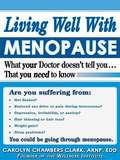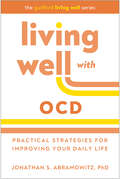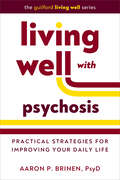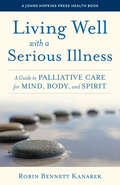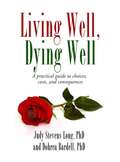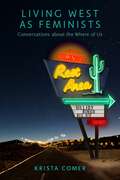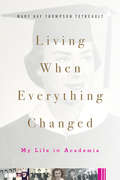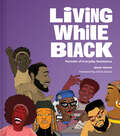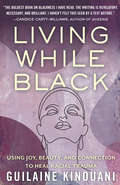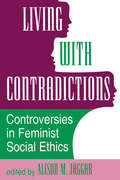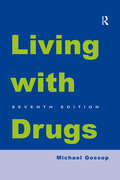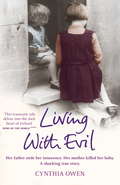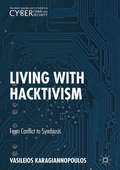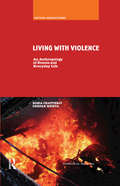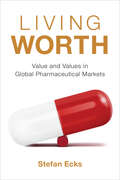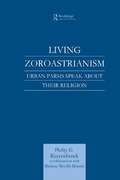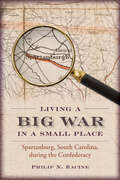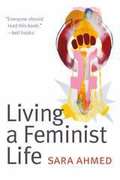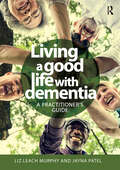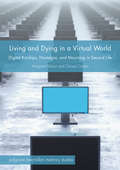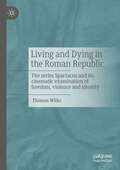- Table View
- List View
Living Well with Menopause: What Your Doctor Doesn't Tell You That You Need to Know
by Carolyn Chambers ClarkNurse and educator describes a thorough holistic approach to menopause. Gives advice on hot flashes, emotional changes, pain, fatigue, weight gain, decreased sex drive, bladder difficulty, insomnia, fuzzy thinking, and more.
Living Well with OCD: Practical Strategies for Improving Your Daily Life (Guilford Living Well Series)
by Jonathan S. AbramowitzOver decades, noted authority Jonathan S. Abramowitz has helped thousands of people use the best science-based strategies to overcome obsessive–compulsive disorder (OCD). But if you have OCD--whether in treatment or not--you know that some days are harder than others. If you are looking for empathic support to navigate the rough patches when OCD disrupts your life, this book is for you! Get step-by-step ideas and downloadable practical tools for coping with lingering obsessional thoughts and doubts, riding out compulsive urges, and staying on track at work or in school. Dr. Abramowitz offers tips for navigating relationships and solving problems with family members, friends, and romantic partners. In short, engaging chapters, this book helps you cultivate resilience, replace self-criticism with self-compassion, and build the life you want--even with OCD.
Living Well with Psychosis: Practical Strategies for Improving Your Daily Life (The Guilford Living Well Series)
by Aaron P. BrinenFor people with psychosis, recovery is a winding path, not a straight line. And the best person to steer your recovery is you. Leading psychologist Aaron P. Brinen busts myths and helps you build the life you want in this empowering book. Dr. Brinen provides step-by-step guidance for becoming a strong self-advocate, navigating treatment options, managing symptoms that cause distress, and coping with stigma. Learn crucial ways to connect with others, pursue your goals at school or work, and keep your body healthy. The brief chapters are warm and compassionate, with downloadable practical tools designed to boost your energy and motivation for getting out into the world. This is a book you can read cover to cover--or dip into any time you need extra support to live well and feel good.
Living Well with a Serious Illness: A Guide to Palliative Care for Mind, Body, and Spirit (A Johns Hopkins Press Health Book)
by Robin Bennett KanarekA practical guide for understanding how palliative care can improve quality of life for patients and their caregivers.Robin Bennett Kanarek was a registered nurse working with patients suffering from chronic medical conditions when her ten-year-old son was diagnosed with leukemia. As her son endured grueling treatments, Robin realized how often medical professionals overlook critical psychological, emotional, and spiritual support for people with life-threatening illnesses. Living Well with a Serious Illness is the culmination of decades of Robin's work to advance the field of palliative care.Although palliative care is often associated with hospice and end-of-life planning, Kanarek argues for a more expanded definition that incorporates palliative care earlier in patients' journeys. Living Well with a Serious Illness helps patients and their caregivers understand• what palliative care entails• how to access the support they need when going through a serious illness• what questions to ask medical professionals • how to navigate advanced care planning• definitions of common terminology used with end-of-life planning• the importance of spiritual care, coping strategies, and emotional support• how to become an advocate for palliative careThis book illuminates the importance of seeing patients as individuals who can benefit from care for their body, mind, and spirit—the core tenet of palliative care.
Living Well, Dying Well: A guide to choices, costs, and consequences
by Judy Stevens-Long Dohrea BardellAttitudes to death and dying are changing in the United States. Today, we are living longer, yet with the acute awareness that what we do now will affect our remaining time. Prompted by a big push from baby boomers, our society is moving towards a culture that provides a greater array of positive choices in the final phase of our lives. This should inspire all of us to find new ways to create joy and comfort until the very last moment of life. Written by Social Sciences Professor Dr. Judy Stevens-Long, author of the bestselling book Adult Life, with Dr. Dohrea Bardell, a Fellow at the Institute for Social Innovation, this book contains all the information you need to ensure that the last years of your life, or the life of someone you love, will be as satisfying, comfortable, and as productive as possible.
Living West as Feminists: Conversations about the Where of Us
by Krista ComerIn the aftermath of the 2020 U.S. presidential election, Krista Comer invited fifteen colleagues into a conversation about feminism and the U.S. West. From her travels over some thirteen thousand miles to places chosen by participants comes a remarkable series of dialogues focusing on questions about the where of us—the places that we love or belong, or don&’t belong, and who we are in them.Living West as Feminists moves from travelogue to interviews to critical meditations. It asks who one&’s people are, to whom one feels accountable, and how we might make peace with the itinerant, often displaced lives of late-stage capitalist culture. Ultimately, the book understands feminism not as a specific politics or set of theories but as a network of relations. Its coalitional perspective allows for coming together even while distinguishing feminists who write from Black, Indigenous, queer, Chicanx, and materialist perspectives. Feminist rest areas, in which relational securities find footing, can create the most priceless resource in desperate times: well-being and political hope.
Living When Everything Changed: My Life in Academia
by Mary Kay TetreaultEntering the academy at the dawn of the women’s rights movement in the late 1960s and early 1970s, the first generation of feminist academics had a difficult journey. With few female role models, they had to forge their own path and prove that feminist scholarship was a legitimate enterprise. Later, when many of these scholars moved into administrative positions, hoping to reform the university system from within, they encountered entrenched hierarchies, bureaucracies, and old boys’ networks that made it difficult to put their feminist principles into practice. In this compelling memoir, Mary Kay Thompson Tetreault describes how a Catholic girl from small-town Nebraska discovered her callings as a feminist, as an academic, and as a university administrator. She recounts her experiences at three very different schools: the small progressive Lewis & Clark College, the massive regional university of Cal State Fullerton, and the rapidly expanding Portland State University. Reflecting on both her accomplishments and challenges, she considers just how much second-wave feminism has transformed academia and how much reform is still needed. With remarkable candor and compassion, Thompson Tetreault provides an intimate personal look at an era when both women’s lives and university culture changed for good. The Acknowledgments were inadvertently left out of the first printing of this book. We apologize for the oversight, and offer them here instead. Future printings will include this information. (https://d3tto5i5w9ogdd.cloudfront.net/wp-content/uploads/2019/08/29185420/Thompson-Tetreault-Acknowledgments.pdf)
Living While Black: Portraits of Everyday Resistance
by Ajuan ManceIn homage to the radical power of art, Living While Black celebrates the small acts of resistance that comprise the daily lives of Black folks by presenting them in a series of vivid illustrations.Laughing. Grieving. Being a kid. Even the purest expression of pleasure, the most human display of sorrow, or the simplest delight of childhood is an act of resistance if you happen to be Black. This immersive hardcover book features forty defiantly joyful illustrations by artist and educator Ajuan Mance, each artwork depicting a person of African descent going about their everyday business. Begun as Mance's personal response to the groundswell of Black Lives Matter protests in 2020, Living While Black denounces the excessive surveillance, harassment, and violence aimed at Black folks engaged in the activities of everyday life—and celebrates the courage and resilience of the Black community. Fittingly, the book also features a foreword from Alicia Garza, BLM founder and principal at the Black Futures Lab. Mance's thoughtful meditation on what it's like to be Black in America makes a wonderful tool for teachers, students, activists, and parents navigating conversations about racism and resistance.POWERFUL MESSAGE: In the contrast between the colorful illustrations and the weighty subject matter, a powerful message emerges: No matter how strong the forces of oppression, Black people will persist in striving for justice, equality, and joy. The book itself is also a reminder that there are many ways to be an activist—from marching for what you believe in, to spreading a message with your art.VIBRANT ARTWORK: Bright colors, bold shapes, vivid patterns—Ajuan Mance's artwork speaks to the enduring power and importance of joy.EXCEPTIONAL TEACHING TOOL: To provide context for the artwork, Mance has compiled a timeline of recent events that lend urgency to the fight for Black lives—she highlights the ways that the conversation has shifted since cell phones allowed bystanders to document instances of racial injustice and violence and offers an entry point for anyone who wants to learn about the roots of contemporary racial justice movements.Perfect for:Activists and agitatorsArt book loversStudents of Black historyTeachers and parents looking for colorful ways to talk to young people about activism and resistance
Living While Black: Using Joy, Beauty, and Connection to Heal Racial Trauma
by Guilaine KinouaniA powerful look at the impacts of anti-Black racism and a practical guide for overcoming racial trauma through radical self-care as a form of resistanceOver the past 15 years, radical psychologist Guilaine Kinouani has focused her research, writing, and workshops on how racism affects both physical and mental health. Living While Black gives voice to the diverse, global experiences of Black people, using personal stories, powerful case studies, and eye-opening research to offer expert guidance on how to set boundaries and process micro-aggressions; protect children from racism; handle difficult race-based conversations; navigate the complexities of Black love; and identify and celebrate the wins. Based on her findings, Kinouani has devised tried-and-tested strategies to help protect Black people from the harmful effects of verbal, physical, and structural racism. She empowers Black readers to adopt self-care mechanisms to improve their day-to-day wellness to help them thrive, not just survive, and to find hope and beauty—or even joy—in the face of racial adversity. She also provides a vital resource for allies seeking to better understand the impacts of racism and how they can help. With the rise of far-right ideologies and the increase of racist hate crimes, Living While Black is both timely and instrumental in moving conversations from defining racism for non-Black majorities to focusing on healing and nurturing the mental health of those facing prejudice, discrimination, and the lasting effects of the violence of white supremacy.
Living With Contradictions: Controversies In Feminist Social Ethics
by Alison M JaggarAiming to demonstrate that feminist ethics is a rich and complex subject, rather than just a series of dogmatic positions on "women's" issues such as abortion rights and pornography, this anthology starts with the assumption that feminism demands an examination of moral issues with a commitment to ending women's subordination. It sets out to show that is is no longer sensible or viable to divide social issues into those that are feminist and those that are not. The wide-ranging contributions, by writers such as Carole Patemen, Andrea Dworking, Janet Radcliffe Richards, Alice Walker, John Berger, Cynthia Enloe and Thomas W. Laquer, address moral issues which include militarism, environmentalism and the treatment of animals.
Living With Drugs
by Michael GossopNow in its seventh edition, Living with Drugs continues to be a well-respected and indispensable reference tool. Michael Gossop has updated this new edition to take account of new laws and practices that have come in to place since the previous edition, published in 2007. Written in an accessible style and providing a balanced perspective, the book is ideal for non-specialists in training, such as student nurses and social workers and for anyone with an interest in this complex, ever-present and emotive issue.
Living With Evil
by Cynthia OwenCynthia Owen grew up in Ireland, went to the local convent school, said her prayers and took her first communion with all the other girls in her class. But behind the façade of respectability lurked a hideous reality.Cynthia was just eight years old when she was sexually abused by her father amongst others. Shortly before her eleventh birthday she was made pregnant and, minutes after giving birth to the baby, Cynthia watched in horror as her own mother murdered the tiny infant, named Noleen, by repeatedly stabbing her with a knitting needle. Cynthia’s mother then wrapped the baby girl in a plastic bag, dumped her in an alleyway and made her daughter go back to school and pretend nothing had ever happened.After enduring many more years of rape and violence, Cynthia came forward and reported her abuse and Noleen’s death.Finally, in 2007, after a fifteen-year legal fight to have her baby girl formally identified, the jury at the ‘Dun Laoghaire Baby’ inquest declared that the baby found dead in an alleyway thirty-four years previously was Noleen Murphy, the daughter of Cynthia Owen.Cynthia’s is a horrific story of brutality and loss, but ultimately, it is an account of love, immense bravery and her fight for justice in Noleen’s name.
Living With Hacktivism: From Conflict To Symbiosis (Palgrave Studies In Cybercrime And Cybersecurity Ser.)
by Vasileios KaragiannopoulosThis book focuses on the phenomenon of hacktivism and how it has been dealt with up to now in the United States and the United Kingdom. After discussing the birth of the phenomenon and the various relevant groups, from Electronic Disturbance Theater to Anonymous, their philosophies and tactics, this timely and original work attempts to identify the positive and negative aspects hacktivism through an analysis of free speech and civil disobedience theory. Engaging in this process clarifies the dual nature of hacktivism, highlighting its potential for positive contributions to contemporary politics, whilst also demonstrating the risks and harms flowing from its controversial and legally ambiguous nature. Based on this hybrid nature of hacktivism, Karagiannopoulos proceeds to offer a critique of the current responses towards such practices and their potential for preserving the positive elements, whilst mitigating the risks and harms involved in such political practices. Finally, the study focuses on identifying an alternative, symbiotic rationale for responding to hacktivism, based on a cluster of micro-interventions moving away from the conflict-based criminal justice model and the potentially unjust and inefficacious results it entails.
Living With Violence: An Anthropology of Events and Everyday Life (Critical Asian Studies)
by Roma Chatterji Deepak MehtaThis book gives a detailed account of the ‘communal riots’ between Hindus and Muslims in Mumbai in 1992-93. It departs from the historiography of the riot, which assumes that Hindu-Muslim conflict is independent of the participants of the violence.Speaking to and interacting with the residents of Dharavi, the largest shanty town in the city, the authors collected a wide range of narrative accounts of the violence and the procedures of rehabilitation that accompanied the violence. The authors juxtapose these narrative accounts with public documents exploring the role language, work, housing and rehabilitation have on the day-to-day life of people who live with violence.
Living Worth: Value and Values in Global Pharmaceutical Markets (Critical Global Health: Evidence, Efficacy, Ethnography)
by Stefan EcksIn Living Worth Stefan Ecks draws on ethnographic research on depression and antidepressant usage in India to develop a new theory of value. Framing depressive disorder as a problem of value, Ecks traces the myriad ways antidepressants come to have value, from their ability to help make one’s life worth living to the wealth they generate in the multibillion-dollar global pharmaceutical market. Through case studies that include analyses of the different valuation of generic and brand-name drugs, the origins of rising worldwide depression rates, and the marketing, prescription, and circulation of antidepressants, Ecks theorizes value as a process of biocommensuration. Biocommensurations—transactions that aim or claim to make life better—are those forms of social, medical, and corporate actions that allow value to be measured, exchanged, substituted, and redistributed. Ecks’s theory expands value beyond both a Marxist labor theory of value and a free market subjective theory, thereby offering new insights into how the value of lives and things become entangled under neoliberal capitalism.
Living Your Dying
by Stanley KelemanThis book explores the little dyings of our lives and their relationship to the overall dying process.
Living Zoroastrianism: Urban Parsis Speak about their Religion
by Philip G. KreyenbroekThis text describes the realities of modern Parsi religion through 30 interviews in which urban Parsis belonging to different social milieus and religious schools of thought discuss various aspects of their religious lives. Zoroastrianism, the faith founded by the Iranian prophet Zarathustra, originated around 1000BCE and is widely regarded as the world's first revealed religion. Although the number of its followers declined dramatically in the centuries after the 7th century Islamic conquest of Iran, Zoroastrians survive in Iran to the present day. The other major Zoroastrian community are the Parsis of India, descendants of Zoroastrians who fled Muslim dominion.
Living a Big War in a Small Place: Spartanburg, South Carolina, during the Confederacy
by Philip N. RacineA history of life in one South Carolina city during the American Civil War, featuring personal stories from those who were there.Most of what we know about how the Civil War affected life in the Confederacy is related to cities, troop movements, battles, and prominent political, economic, or military leaders. Far less is known about the people who lived in small Southern towns remote from marching armies or battles. Philip N. Racine explores life in one such place—Spartanburg, South Carolina—in an effort to reshape the contours of that great conflict.By 1864 life in most of the Confederacy, but especially in rural towns, was characterized by scarcity, high prices, uncertainty, fear, and bad-tempered neighbors. Shortages of food were common. People lived with constant anxiety that a soldiering father or son would be killed or wounded. Taxes were high, inflation was rampant, good news was scarce and seemed to always be followed by bad. The slave population was growing restive as their masters’ bad news was their good news. Army deserters were threatening lawlessness; accusations and vindictiveness colored the atmosphere and added to the anxiety, fear, and feeling of helplessness. Often people blamed their troubles on the Confederate government in faraway Richmond, Virginia.Racine provides insight into these events through personal stories: the plight of a slave; the struggles of a war widow managing her husband’s farm, ten slaves, and seven children; and the trauma of a lowcountry refugee’s having to forfeit a wealthy, aristocratic way of life and being thrust into relative poverty and an alien social world. All were part of the complexity of wartime Spartanburg District.“A well-written account that not only captures the plight of both the black and white population, but also offers some amazing cameos, especially the life of Emily Lyle Harris, who struggled to keep her large family in tact while her husband went off to war. This is a lively read and a perfect book to assign for classes covering the Carolina Upstate during the American Civil War.” —Edmund L. Drago, professor of history, The College of Charleston, and author of Confederate Phoenix: Rebel Children and Their Families in South Carolina“Living a Big War offers a fascinating, unflinching look at the toll the Civil War took on Spartanburg, clearly showing divisions that emerged and deftly employing stories of slaves, women, and other individuals to reveal the experiences of people on the home front.” —Gaines M. Foster, dean, College of Humanities and Social Sciences, Louisiana State University, and author of Ghosts of the Confederacy: Defeat, the Lost Cause and the Emergence of the New South, 1865–1913
Living a Feminist Life
by Sara AhmedIn Living a Feminist Life Sara Ahmed shows how feminist theory is generated from everyday life and the ordinary experiences of being a feminist at home and at work. Building on legacies of feminist of color scholarship in particular, Ahmed offers a poetic and personal meditation on how feminists become estranged from worlds they critique—often by naming and calling attention to problems—and how feminists learn about worlds from their efforts to transform them. Ahmed also provides her most sustained commentary on the figure of the feminist killjoy introduced in her earlier work while showing how feminists create inventive solutions—such as forming support systems—to survive the shattering experiences of facing the walls of racism and sexism. The killjoy survival kit and killjoy manifesto, with which the book concludes, supply practical tools for how to live a feminist life, thereby strengthening the ties between the inventive creation of feminist theory and living a life that sustains it.
Living a good life with Dementia: A practitioner's guide
by Liz Leach Murphy Jayna PatelA practical guide to helping those living with dementia live their best life in a way that makes sense to them.Essential reading for anyone working with people living with dementia, this book explains the concept of Self-Directed Support and Care for people living with dementia and links the various Person Centred approaches within dementia care with Person Centred Planning and Community based approaches. As the content unfolds, the concept of the Dementia Care Triad (people living with dementia, unpaid carers and professional carers) is explored and developed further to include the layer of community. The links between the health and social care legal context, guidance documents and national dementia strategies are presented with good, actionable practice, approaches, tools and informed advice to achieve Person Centred dementia care and support, with an emphasis on communities Living a Good Life with Dementia will help professionals and carers gain knowledge and insight to be able to develop creative ideas for the care and support they want to have in place.
Living and Dying in a Virtual World: Digital Kinships, Nostalgia, and Mourning in Second Life (Palgrave Macmillan Memory Studies)
by Margaret Gibson Clarissa CardenThis book takes readers into stories of love, loss, grief and mourning and reveals the emotional attachments and digital kinships of the virtual 3D social world of Second Life. At fourteen years old, Second Life can no longer be perceived as the young, cutting-edge environment it once was, and yet it endures as a place of belonging, fun, role-play and social experimentation. In this volume, the authors argue that far from facing an impending death, Second Life has undergone a transition to maturity and holds a new type of significance. As people increasingly explore and co-create a sense of self and ways of belonging through avatars and computer screens, the question of where and how people live and die becomes increasingly more important to understand. This book shows how a virtual world can change lives and create forms of memory, nostalgia and mourning for both real and avatar based lives.
Living and Dying in the Roman Republic: The Series Spartacus and its Cinematic Examination of Freedom, Violence and Identity
by Thomas WilkeThis volume deals with the American production "Spartacus" and the British-American-Italian co-production Rome. In the examination of the present, a turn to Greek or Roman antiquity can be observed again and again. To find there the roots of Western society for politics, economics or philosophy, or to derive comparative arguments for expansionist efforts or decline, is not just part of the rhetorical commonplace. So it is not surprising that the TV series format also takes up this period. Whereas in Rome the attempt is made to work through the historical guidelines in great detail, in Spartacus, apart from the rough sketch of the plot, one can speak of a far-reaching neglect of the historical situation. From a (media) ethical perspective, specific approaches to responsibility, the transmission of values, loyalty, education, self-discipline, and religion can be identified in the series, which can be interpreted as self-statements of the present or the producers.
Living and Working Together (Families, Book #2)
by Dahia ShabakaSocial Studies textbook for Grade 1
Living and Working Together (Living And Working Together)
by Dahia ShabakaSocial Studies textbook for Grade 1
Living and Working Together: Neighborhoods Book 1
by Dahia ShabakaSocial Studies textbook for 2nd Grade
